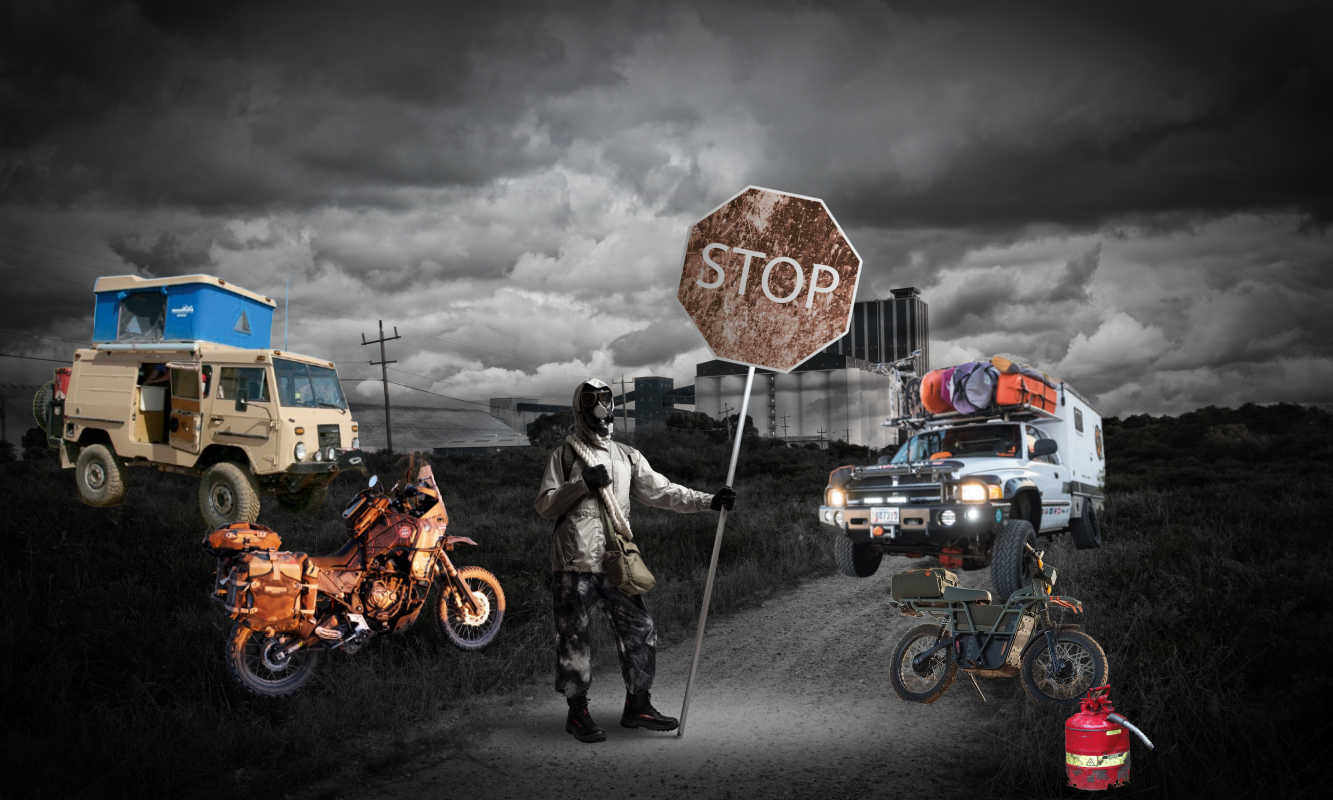
Electric vs Gas vs Diesel: What’s the Best Bug-Out Vehicle for SHTF Survival?
Electric vs Gasoline vs Diesel: What’s the Best Vehicle for Long-Term Survival in a Disaster?
In a large-scale disaster or societal collapse, the question isn’t just where you’ll go—it’s how you’ll get there. When the grid fails, fuel runs dry, and roads clog with chaos, your vehicle could be the difference between life and death.
Whether you're planning a bug-out, building a homestead, or prepping for the unknown, the right vehicle setup matters.
So which is better for long-term survival in a disaster situation in the U.S.?
Electric vehicles (EVs), gasoline vehicles, diesel trucks, gas scooters, or e-bikes?
Let’s break it down from a prepper’s perspective—with durability, self-sufficiency, availability, and off-grid practicality as our top criteria.
🚗 1. Gasoline Vehicles: America’s Go-To, but Built on Fragile Supply Chains
 🔋 Pros:
🔋 Pros:
-
Widely available: Gasoline is still the most accessible fuel across the U.S.
-
Familiarity: Mechanics, parts, and know-how are easy to find.
-
Speed & range: You can cover long distances fast.
-
Diverse choices: Sedans, trucks, SUVs, and compact cars in every configuration imaginable.
❌ Cons:
-
Highly dependent on supply chains: In a disaster, gas stations may run dry in hours.
-
Short shelf life: Unstabilized gasoline degrades in 3–6 months.
-
Loud & conspicuous: Bad for stealth, especially in contested or urban environments.
🧠 Survival Verdict:
Gasoline vehicles are great for short-term escape scenarios (e.g., bugging out in the first 72 hours). But for long-term disaster survival, gas becomes a liability unless you’re actively rotating and stabilizing your fuel.
🚛 2. Diesel Vehicles: Built to Last, Ideal for Homesteaders and Rural Preppers
 🔋 Pros:
🔋 Pros:
-
Better fuel storage: Diesel lasts longer—12+ months without additives, 5+ years with proper stabilization.
-
Fuel flexibility: Many older diesels can run on biodiesel or waste vegetable oil.
-
Torque and hauling power: Ideal for off-road travel, pulling trailers, or bug-out campers.
-
Mechanical simplicity: Pre-2000 diesel trucks (like old 12-valve Cummins or 7.3 Power Stroke Fords) have fewer electronics and are EMP-resilient.
❌ Cons:
-
Fuel still finite: Even biodiesel requires infrastructure to produce.
-
Harder to find parts: Especially in rural or remote areas.
-
Heavier vehicles: Not ideal for sneaking through narrow terrain or footpaths.
🧠 Survival Verdict:
If you plan to stay mobile for months or build a fortified homestead, diesel wins. It’s reliable, powerful, and long-lasting—especially when paired with your own biodiesel production or off-grid fuel storage.
⚡ 3. Electric Vehicles: Silent and Green, but Grid Dependent (Mostly)
 🔋 Pros:
🔋 Pros:
-
Silent operation: Great for stealth travel in rural or urban areas.
-
No fuel dependency: Recharge via solar panels, generators, or off-grid setups.
-
Low maintenance: No oil changes, fewer moving parts.
-
Torque: Instant power delivery—perfect for quick getaways or rugged terrain.
❌ Cons:
-
Charging time: Long recharge cycles unless you have high-output solar or a backup battery bank.
-
Grid dependency: If the power grid is down and you’re not solar-ready, you’re stuck.
-
Battery lifespan: EV batteries degrade after 8–15 years and are hard to replace post-collapse.
-
Cold weather performance: Batteries lose efficiency and range in subzero temperatures.
🧠 Survival Verdict:
EVs can be incredible tools in a self-sufficient homestead setup powered by solar—but for off-grid bug-outs or grid-down chaos, they’re risky unless you’re well-prepared and stationary.
🛵 4. Gas Scooters & Motorcycles: Compact, Fuel-Efficient, and Urban-Friendly
 🔋 Pros:
🔋 Pros:
-
Fuel-sipping machines: Some scooters get 100+ MPG.
-
Easy to maneuver: Great for weaving through debris, traffic, or off-road trails.
-
Easier to stash: Small enough to hide, store indoors, or even take off-road.
-
Lower fuel needs: A few gallons can last weeks.
❌ Cons:
-
Limited cargo: Carrying supplies or people is a challenge.
-
No protection: You’re exposed to weather, danger, and road hazards.
-
Still fuel-dependent: Without stable gas storage, you’re grounded.
🧠 Survival Verdict:
Perfect for urban escape routes or short-haul recon. In long-term survival, they’re best used as backup transportation or scouting vehicles when fuel and weight are tight.
🚴 5. E-Bikes: Lightweight, Rechargeable, and Ultra-Stealthy
 🔋 Pros:
🔋 Pros:
-
Silent & fast: Great for quick, quiet travel without drawing attention.
-
Solar-compatible: Chargeable with portable solar panels or battery banks.
-
Lightweight: Easy to carry over obstacles, stash indoors, or bring inside a camper.
-
Pedal backup: Run out of power? Just pedal like a regular bike.
-
Low maintenance: No gas, oil, or complex systems.
❌ Cons:
-
Limited range: Most e-bikes only go 20–40 miles on a charge.
-
Limited hauling: Tough to carry large gear unless you’ve added panniers or a trailer.
-
Durability: Cheaper models may not survive rugged off-road use or harsh weather.
🧠 Survival Verdict:
The ultimate bug-out vehicle for solo preppers in urban and suburban environments. Pair an e-bike with solar charging and you’ve got an EMP-safe, grid-free ride that’s fast and silent.
⚖️ Fuel Storage & Grid Independence: The True Game-Changer
 In a long-term survival event, the vehicle itself matters less than your ability to fuel or power it off-grid. Consider these facts:
In a long-term survival event, the vehicle itself matters less than your ability to fuel or power it off-grid. Consider these facts:
-
Gasoline lasts ~6 months (unless treated).
-
Diesel lasts 1–5 years, especially stabilized and stored in steel drums.
-
Solar setups paired with e-bikes or EVs offer unlimited "free" power, but require upfront investment.
-
Portable solar panels and battery banks are now more affordable than ever—perfect for charging e-bikes and devices.
🔥 Prep Tip: No matter the vehicle, invest in manual fuel pumps, stabilizers, and solar generators. Independence starts with the ability to power your tools—on your terms.
🛠️ Best Vehicles for Specific Survival Scenarios

| Scenario | Best Vehicle Option |
|---|---|
| Urban Bug-Out | Gas Scooter or E-Bike (quiet, maneuverable, fuel/solar efficient) |
| Rural Homestead | Diesel Truck (torque, longevity, biofuel-compatible) |
| Mobile Survivalist | Diesel Van or Truck w/ Camper Shell or Trailer |
| EMP-Proof Setup | Pre-1980 Diesel Vehicle or E-Bike w/ Solar |
| Silent Operations / Stealth | E-Bike or EV (if charged off-grid) |
| Fuel Scarcity | E-Bike or Biodiesel-Capable Diesel Vehicle |
🔥 Final Take: The Long-Term Survival Vehicle Showdown
So, which machine truly reigns supreme in long-term survival? Here's our survivalist conclusion:
-
Best Overall for Grid-Down Survival: 🥇 Older Diesel Truck
Long fuel life, biofuel compatibility, EMP resilience, and off-road ability make it king for homesteaders and long-haul preppers. -
Best Urban or Lightweight Option: 🥈 E-Bike + Solar Charger
Stealth, solar rechargeability, and low-profile mobility make e-bikes unbeatable in tight situations. -
Best Short-Term Escape Vehicle: 🥉 Gasoline SUV or Motorcycle
Fast, powerful, and common—perfect for bugging out in the early chaos.

No matter what you drive, the secret to long-term survival isn’t just the vehicle—it’s the infrastructure you build around it. Fuel, power, repairability, and sustainability are the real keys to survival mobility.
Whether you're prepping for a blackout, EMP, or full-blown collapse, we've got your back. Visit us in-store or online to get survival-ready today.
#BetterBushcraft #SurvivalVehicles #PreppingUSA #DieselVsGas #EbikeForSurvival #GridDownPrepping #BugOutVehicles #OffGridLife #SelfReliance #EMPReady

